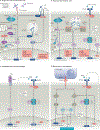Type I interferon in rheumatic diseases
- PMID: 29559718
- PMCID: PMC6625751
- DOI: 10.1038/nrrheum.2018.31
Type I interferon in rheumatic diseases
Abstract
The type I interferon pathway has been implicated in the pathogenesis of a number of rheumatic diseases, including systemic lupus erythematosus, Sjögren syndrome, myositis, systemic sclerosis, and rheumatoid arthritis. In normal immune responses, type I interferons have a critical role in the defence against viruses, yet in many rheumatic diseases, large subgroups of patients demonstrate persistent activation of the type I interferon pathway. Genetic variations in type I interferon-related genes are risk factors for some rheumatic diseases, and can explain some of the heterogeneity in type I interferon responses seen between patients within a given disease. Inappropriate activation of the immune response via Toll-like receptors and other nucleic acid sensors also contributes to the dysregulation of the type I interferon pathway in a number of rheumatic diseases. Theoretically, differences in type I interferon activity between patients might predict response to immune-based therapies, as has been demonstrated for rheumatoid arthritis. A number of type I interferon and type I interferon pathway blocking therapies are currently in clinical trials, the results of which are promising thus far. This Review provides an overview of the many ways in which the type I interferon system affects rheumatic diseases.
Figures

Similar articles
-
Pathogenesis and treatment of autoimmune rheumatic diseases.Curr Opin Rheumatol. 2019 May;31(3):307-315. doi: 10.1097/BOR.0000000000000594. Curr Opin Rheumatol. 2019. PMID: 30920455 Free PMC article. Review.
-
Chemokines in rheumatic diseases: pathogenic role and therapeutic implications.Nat Rev Rheumatol. 2019 Dec;15(12):731-746. doi: 10.1038/s41584-019-0323-6. Epub 2019 Nov 8. Nat Rev Rheumatol. 2019. PMID: 31705045 Review.
-
Interferon lambda in inflammation and autoimmune rheumatic diseases.Nat Rev Rheumatol. 2021 Jun;17(6):349-362. doi: 10.1038/s41584-021-00606-1. Epub 2021 Apr 27. Nat Rev Rheumatol. 2021. PMID: 33907323 Free PMC article. Review.
-
The Pharmacological Mechanisms and Therapeutic Activities of Hydroxychloroquine in Rheumatic and Related Diseases.Curr Med Chem. 2017;24(20):2241-2249. doi: 10.2174/0929867324666170316115938. Curr Med Chem. 2017. PMID: 28302011 Review.
-
Novel immunological targets in rheumatic diseases: clues from current therapies.Drug Discov Today. 2014 Aug;19(8):1155-60. doi: 10.1016/j.drudis.2014.06.021. Epub 2014 Jun 28. Drug Discov Today. 2014. PMID: 24984284 Review.
Cited by
-
EZH2 Inhibition Interferes With the Activation of Type I Interferon Signaling Pathway and Ameliorates Lupus Nephritis in NZB/NZW F1 Mice.Front Immunol. 2021 Mar 26;12:653989. doi: 10.3389/fimmu.2021.653989. eCollection 2021. Front Immunol. 2021. PMID: 33868295 Free PMC article.
-
SIGLEC-1 in Systemic Sclerosis: A Useful Biomarker for Differential Diagnosis.Pharmaceuticals (Basel). 2022 Sep 28;15(10):1198. doi: 10.3390/ph15101198. Pharmaceuticals (Basel). 2022. PMID: 36297311 Free PMC article.
-
Analysis of human total antibody repertoires in TIF1γ autoantibody positive dermatomyositis.Commun Biol. 2021 Mar 26;4(1):419. doi: 10.1038/s42003-021-01932-6. Commun Biol. 2021. PMID: 33772100 Free PMC article.
-
Serum Inflammatory Profile in Hereditary Transthyretin Amyloidosis: Mechanisms and Possible Therapeutic Implications.Brain Sci. 2022 Dec 12;12(12):1708. doi: 10.3390/brainsci12121708. Brain Sci. 2022. PMID: 36552168 Free PMC article.
-
The Transcriptomic Profile of Monocytes from Patients With Sjögren's Syndrome Is Associated With Inflammatory Parameters and Is Mimicked by Circulating Mediators.Front Immunol. 2021 Aug 3;12:701656. doi: 10.3389/fimmu.2021.701656. eCollection 2021. Front Immunol. 2021. PMID: 34413853 Free PMC article.
References
Publication types
MeSH terms
Substances
Grants and funding
LinkOut - more resources
Full Text Sources
Other Literature Sources

